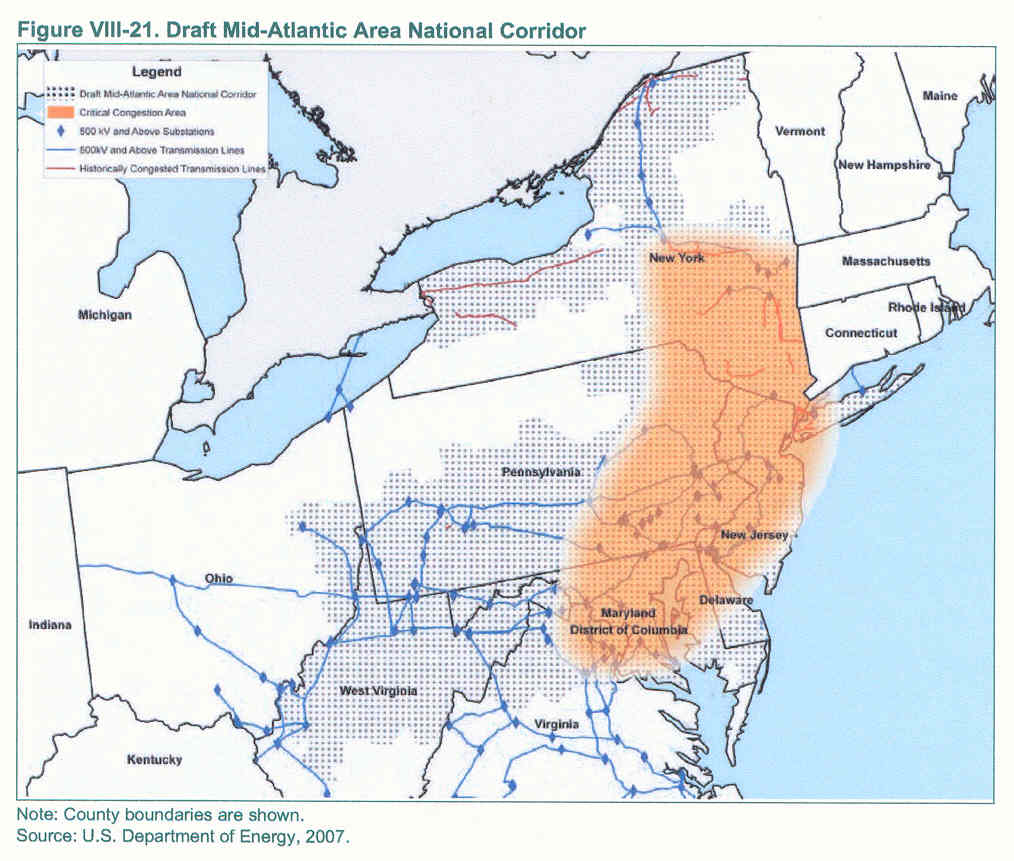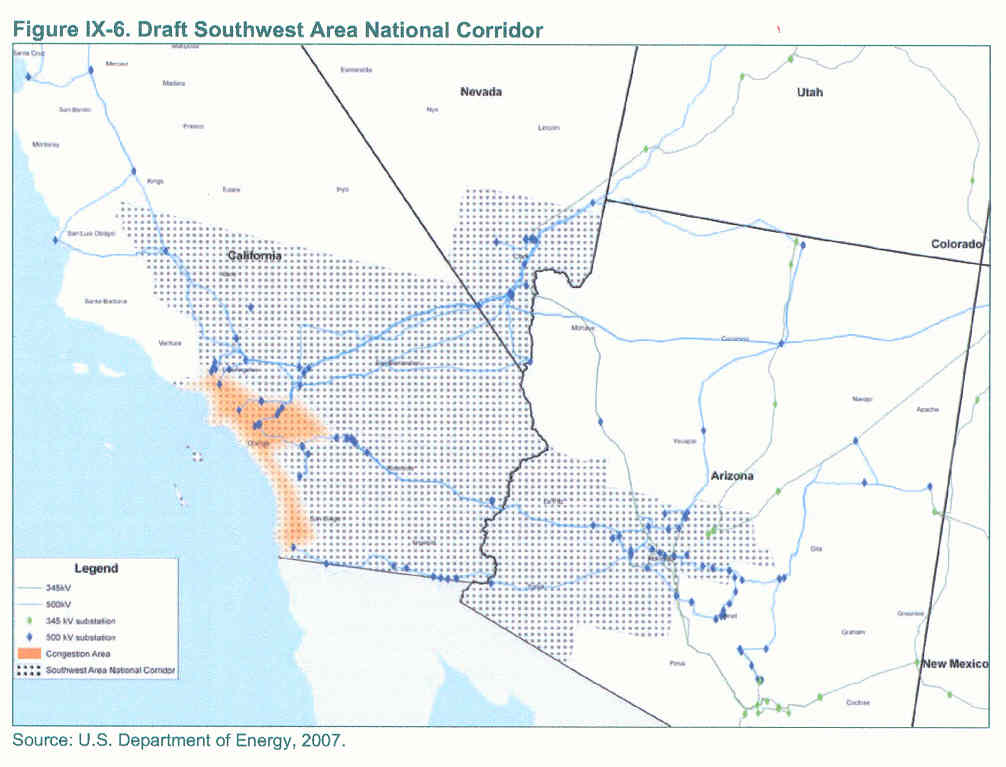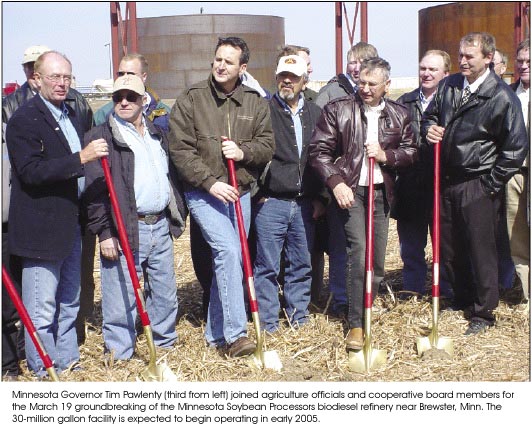Comment on proposed Transmission Corridors
April 29th, 2007
.
Transmission lines may be coming your way, through federal pre-emption of state processes that give transmission lines the scrutiny they require. They’re working to transfer jurisdiction of transmission siting out of the hands of the states and into the hands of FERC, we’ve been hearing about this for a while, they’ve got the authority to do it, and now there are specific transmission corridors proposed. Well, as specific as you can get with a 100-200 mile wide corridor!
Is this what you want? Do you want the feds to have power of eminent domain to give utilities what they want — YOUR LAND? Do you want these National Transmission Corridors through your yard? Do you want them to get away with characterizing transmission of market transactions, bulk power transfer, as necessary for “national security?”
NATIONAL ELECTRIC TRANSMISSION CORRIDORS WERE ANNOUNCED LAST WEEK. NOW’S THE TIME TO REGISTER YOUR COMMENTS!
Public Comment Period is 60 days, beginning on April 26, 2006, and ending on (I think) June 25, 2007 (depending on how they count!). They claim that comments received or postmarked within the 60-day comment period will be considered, but I recommend making sure it GETS THERE by the deadline, I hate to rely on their statement about postmarks!
They have the above Public Comment Form on their site, and if you use this, I’d recommend printing it out so you have a record of it.
They ask that you specify the docket you’re Commenting on, i.e., Docket No. 2007-OE-01 (the draft Mid-Atlantic Area National Corridor), comments must be marked “Attn: Docket No. 2007-OE-01” and for Docket No. 2007-OE-02 (the draft Southwest Area National Corridor), comments must be marked “Attn: Docket No. 2007-OE-02.”
==========================
This is the proposed Mid-Atlantic Area National Corridor, I’d heard questions about this from Pennsylvania and New York, and it seems it covers half the state of Delaware (that doesn’t take much):
This is the proposed Southwest Area National Corridor:
The U.S. Department of Energy (DOE) is holding three public meetings on the two draft National Corridor Designations announced on April 26, 2007. The meetings are being held in two eastern locations and one southwest location, and they’re not readily accessible. The one in Washington, D.C. is held at a hotel where parking is $18/day and not on a Metro stop — it seems that there MUST be somewhere with a sufficiently large meeting room with parking and more direct accessibility — but who wants that pesky “public” there anyway!
Two public meetings will be held on Docket NO. 2007-OE-01 (the Draft Mid-Atlantic Area National Corridor Designation) – in Arlington, VA, on May 15, 2007, and in New York, NY, on May 23, 2007 – and one public meeting will be held on Docket NO.2007-OE-02 (the Draft Southwest Area National Corridor Designation) – in San Diego on May 17, 2007.
Arlington, VA Meeting on May 15:
Doubletree Hotel Crystal City-National Airport
300 Army Navy Drive
Arlington, VA 22202-2891
Phone: 703-416-4100
(hotel says parking costs $18!)
San Diego, CA Meeting on May 17:
Manchester Grand Hyatt San Diego Hotel
One Market Place
San Diego, California 92101
Phone: (619) 232-1234
New York, NY Meeting on May 23:
Park Central New York Hotel
870 Seventh Avenue at 56th Street
New York, NY 10019-4038
Phone: 212-247-8000
From their blurb:
DOE invites all interested parties to participate in the public meetings and to provide oral and written comments at these sessions in addition to submitting comments in response to the Federal Register Notice on Draft National Interest Electric Transmission Corridor Designations.
Agenda
Each of the three meetings will have the same basic format:
9:00 a.m. – 10:00 a.m. Registration Desk Open
10:00 a.m. – 10:30 a.m. DOE Opening Remarks and Presentation
10:30 a.m. – 12:00 p.m. Public Comments
12:00 p.m. – 1:30 p.m. Lunch (on participants own)
1:30 p.m. – 3:30 p.m. Public CommentsAdvance registration is not required to attend. However, participants who would like to provide oral comments must sign up in advance.
Sign-up to Provide Public Comments at the Meeting
If you would like to present oral comments at one of the meetings, you must register in advance. The opportunity to comment will be limited to 2 minutes per presenter. Those wishing to provide oral comments will present on the day of the meeting in the order in which they are received. Sign-up here to provide public comments.
Each public meeting will be transcribed and the transcript will be posted on the web site following the meeting. To supplement oral comments, written comments may be submitted.
For More Information
For general information on the Draft National Interest Electric Transmission Corridor Designations, please visit http://nietc.anl.gov.
Contacts
Poonum Agrawal (Technical Contact)
Manager
Markets & Technical Integration
Office of Electricity Delivery and Energy Reliability
U.S. Department of Energy
Phone: (202) 586-6048
Email: poonum.agrawal@hq.doe.govLauren Giles (Logistics)
Program Manager
Energetics Incorporated
Phone: (410) 953-6250
Email: LGiles@energetics.com
Here’s a link to PJM Transmission Maps. Most of the affected area is in PJM, though not all.
ConocoPhillips draws a crowd!
April 28th, 2007

ConocoPhillips says it’s paying attention:
“Our industry has lost touch with the public,” said Conoco’s Bob Ridge in his opening statements. “We did a poll, and we found our credibility was below the tobacco industry. We want to listen.”
From the Rochester Post Bulletin:
As I said before, when ConocoPhillips comes to down on the heels of its big technology gamble, coal gasification, going down the hopper in spectacular flames, I’m wary, and I’m downright suspicious when “our” very own Ed Garvey is up there on the bias… er… dais… errrrr… bias… And the CERTs folks are not to happy that I’m asking questions about their promotion of this event, and consenting to parts of two front rows and breakfast the next day (dinner before hand perhaps?) But ConocoPhillips has a lot at stake here, IGCC alone is a tremendous investment, even for the likes of a company that big. Anyway, I was ready, I went with my friend Tom, who’s pretty laid back, and fortified myself with two mango margaroodies from Fiesta before hand — a sure way to keep me quiet throughout. That and my “no bark” collar! Meanwhile, Chuck Michels of SEH and Mike Gregorson of Great Plains Institute were getting a vicarious thrill wondering what’s up in Delaware!?!?! Jeez, get a life… Poor Mike gets assigned to follow me over to Denver 2/12 for our IGCC Conference and then to be in Grand Rapids 2/14 (and he got to fly, not fair…) — hey, Mike, here’s a hint — are you booked yet for the PSC meeting on May 8 in Dover, maybe the deathknell of yet another IGCC project??? See ya there!
Oh, and someone thinks I need to post “my price” on the blog… let’s just keep them guessing.

I was paying attention to Ed Garvey’s Comments, which started with four important points:
1) Humans cause climate change
2) Renew, manage, replace and improve current energy infrastructure
3) Promote renewables
4) Increase conservation and efficiency
As he said that, both Tom and I noticed that conservation and efficiency were DEAD LAST. Better reverse that order! grrrrrrrrrrrrrr…
Anyway, his final four points are supposed to be a policy statement, but the horiffic things that are happening in energy right now show that there’s something wrong here. He’s saying that energy must be:
– Reliable
– Low Cost
– Community Based
– Environmentally Superior
Ummmmm… could someone please let Governor Pawlenty know of his own “policy” points so he’s not supporting unsupportable projects like the boondoggle Mesaba Project, and the massive coal enabling transmission of CapX2020? Ahem…
ConocoPhillips Town Hall Meeting
April 26th, 2007

ConocoPhillips Road Show is coming to your town:
Jan. 17: Reno, Nev. July 18: Wilmington, Del.
From the Inbox from Green Delaware:

ConocoPhillips Town Hall Meeting — “a conversation on energy”
ConocoPhillips (CP) is a major promoter of “(un)clean coal” gasification technology. CP is one of the few vendors of “gasifier” technology, a key element of the heavily-promoted “new” way to burn coal.
CP is a main technology provider for the proposed Mesaba IGCC project in Northern Minnesota.
Minnesota Administrative Law Judges recently recommended that Mesaba not be approved. Here’s the ALJ decision.
On April 26, in Rochester, MN, CP will sponsor one of a national series of meetings at which the giant oil company will present its present views on US energy policy.
A Conversation on Energy will be hosted by ConocoPhillips and the University
of Minnesota, Initiative for Renewable Energy and the Environment (IREE) and
moderated by Richard “Dick” Hemmingsen, Director of IREE. In addition to
speakers from ConocoPhillips, invited panelists include representatives from
the Minnesota Center for Environmental Advocacy, Minnesota Renewable Energy Society and other organizations active in business and industry.
Also see ConocoPhillips Energy Guide.
These “conversations on energy” smell like a public relations campaign by CP and other big fossil fuelers to pretend to do something about global warming, while coopting for-real advocates. They have realized that simple denial won’t work any more and they need a more nuanced line.
Ed Burke, of ConocoPhillips, said that industry researchhas shown “we’ve lost all credibility, we’re at the bottom of the list, below even tobacco!” We’re viewed as caring only about profits and high salaries, and we need to get back in touch with the American people.” He notes that global warming is an issue “and we need to do something about it.” These meetings are not really a hard sell on the company at all. They’re doing meetings in 35 cities, and this is the 11th one. When asked if it has anything to do with the Mesaba Project, he said “absolutely not. It’s about opening a dialog with the Amercan people. It’s about how do we do innovation… new energy solutions…”
Guess? Truly independent voices won’t be prominent at these meetings. We’ll see…
For example, the panelist lineup in Rochester includes:
Loren Abraham of the Minnesota Renewable Energy Society 612.308.4757
Chuck Laszewski of the Minnesota Center for Environmental Advocacy 651.223.5969
Edward Garvey, deputy commissioner of the Combined Energy and Telecommunications division of the Minnesota Department of Commerce
Bob Ridge, CP, Vice-President for Health, Safety and Environmental
Sabrina Watkins, CP, Manager, Advanced Technology
Carol Overland has been a key opponent of IGCC projects. She commented:
“ConocoPhillips is a technology provider for coal gasification projects such as Mesaba. The same technology is utilized at the Wabash River plant that has been such a disaster both economically and environmentally. They are choosing to do a road show at this time when the Mesaba project is going down in flames, and that they are featuring Ed Garvey, a top energy official in Governor Pawlenty’s administration. I’m concerned they are trying to grease the skids for Excelsior Energy, the Mesaba promoters, contrary to the recommendations of the judges assigned to the case. It’s noteworthy that they have scheduled stops in other locations where IGCC projects are proposed, such as Delaware, Alaska, West Virginia, Indiana, New York, Texas, and Arizona. How can it be anything other than a promotional road show?”
Overland is concerned about the participation of representatives of the Minnesota Renewable Energy Society and the Minnesota Center for Environmental Advocacy. “MCEA was ineffective and lackadaisical in opposing the Mesaba Project.”* Â Why is MCEA now cooperating with ConocoPhillips? Thankfully, Fresh Energy [ formerly Minnesotans for an Energy-Efficient Economy] had the sense to turn this “opportunity” down.”
Doug Shoemaker , Co-Chair of the participating Minnesota Renewable Energy Society had some concerns: “… at least on the surface it looks good,” but “we’ve got … [questions] … hanging over our heads.”
Chuck Laszewski of the Minnesota Center for Environmental Advocacy told us: “We thought about it in some depth because were concerned that it could be seen as some sort of greenwashing.” But on balance, MCEA concluded that it would be “a worthwhile opportunity to get our opinions out.”
Corporations are usually more sophisticated than community-based advocacy groups. Is CP successfully using orgs in Minnesota and elsewhere to greenwash itself? Or are these meetings indeed a “worthwhile opportunity?”
We can’t judge doings in Minnesota, but in Delaware many orgs would be flattered to be invited, would crave the exposure, and would hop on board without intelligently considering the consequences of their actions.
The CP road show is scheduled to come to Wilmington, Delaware, on July 18, 2007.
Alan Muller
Alan Muller, Executive Director
Green Delaware
Box 69
Port Penn, DE 19731 USA
302.834.3466
greendel@dca.net
www.greendel.org
* Ineffective and lackidasical? Isn’t that a bit harsh? Well, considering that they presented only a CO2 case, did not deal with the economics of the project, and did not participate in any of the kick ass motions flying around, didn’t argue to free information up to the public and didn’t know that we’d won those motions, didn’t even submit a Summary Motion of any sort… and then there’s this, released last week, knowing that the decision turned on choice of fuel, unreasonable cost and broad emissions non-performance:
“Had the Excelsior proponents made a clear commitment to carbon capture and storage in a reasonable time after it was built, we might have had a different view as to whether the project should go forward,†said Bill Grant, associate executive director of Izaak Walton League of America.
Turkey turds redux
April 26th, 2007
  
Stolen from St. Olaf, an interesting piece on “Thanksgiving and the Environment” (Interior of a turkey barn, 1947. Photo courtesy of the MN Historical Society)
In today’s STrib:
Gov. Pawlenty, who wants to be known as the “Energy Governor,” supports Fibrominn and turkey turd incineration:
As the STrib article notes:
Even in an era when renewable energy has moved from environmental wish lists to mainstream discussions embraced by President Bush, Gov. Tim Pawlenty and labor unions, the business of burning poultry manure has ruffled some feathers.
David Morris lays out the problems. It’s not “green” by any measure:
“Being green means being informed and being sophisticated,” said David Morris of the Institute for Local Self-Reliance, an energy expert and longtime critic of the litter-burning project. “Simply because you’re taking a renewable resource and turning it into something else does not mean that it’s environmentally benign or economically worthwhile.”
and the price is not reasonable:
But even with federal tax incentives, Xcel is paying twice as much for Fibrominn’s power than for wind energy, according to Morris of the Institute for Local Self-Reliance. He said it amounts to an $11-million-a-year subsidy that ratepayers ultimately will pay.
“That’s almost a quarter of a billion in subsidies over the life of this contract,” he said. “And in terms of projected power needs for Xcel or the state, this is a really, really tiny plant. From a systems analysis it stinks. And talking about it from an economic analysis, it stinks.”
Here’s a piece from David Morris:
Here’s the EQB’s Order on Fibrominn:
Findings of Fact, Conclusions of Law and Order Granting Exemption
And on p. 16, there’s a recap of the Senate Committee Hearings on Fibrominn:
A couple of points on the STrib article and turkey turds from Alan Muller, of Green Delaware. Green Delaware was an active part of the effort to run Fibrowatt out of Delaware:
Sent to the STrib:
Nothing short of nuclear reactions can turn poop or anything else into energy. The carbon burns to CO2 and the hydrogen burns to water (H2O). This is a constant misrepresentation made by burner promoters….
Energy is not “created.” This is basic thermodynamics. Some chemical energy is released as thermal energy in the chemical reactions of combustion, and some of this (maybe 85 percent or so) can be captured in the boilers and used to operate steam turbines. The overall thermal efficiency for a plant like this is likely to be on the order of 25-30 percent. The electricity is useful, if very expensive, but against this we need to consider various negative impacts.
This type of facility is likely to be a significant source of air pollution…. “Renewable” does not mean “clean” or “green.” (Note the 350 foot smokestack needed to disperse air pollutants!) It is likely that people living near the facility will suffer health impacts, particular from fine particle pollution and acid gasses.
Removal of poop nutrients from the agricultural cycle is undesirable. Using the ash as fertilizer is not as desirable as using the poop itself as fertilizer. David Morris made this point in his testimony.
Bill Hanna spinning tales for Excelsior again
April 25th, 2007
“Don’t forget, some projects die nine times before they go.â€
No problem. I’ve been working on killing this one since December, 2001, and as the STrib quoted me, it’s “dead, dead, dead. It was on life support, we’ve pulled the plug, and are waiting for the inevitable.”
But from the promoters and their promoters, the spin is dizzying, sore losers who can’t accept well documented reality. The Mesaba Project has been outed and the record is there for the world to see. It’s going down. Finally.

Bill Hanna, Editor of the Mesabi Daily News, is spinning his web of PR deception — there he goes again, claiming a “$1.5 billion” cost — when we’ve provided him with the DOE primary documentation of the $2,155,680,783 cost HOW MANY TIMES???

Micheletti’s spinning — claiming “they only referenced what we had to say one or two times.”  Oh, bull-shit… read the decision.  In the 75 page ALJ recommendation of denial, there are 184 footnotes, and 95 references to Excelsior exhibits and arguments.
Micheletti has whined to at least one reporter that the ALJs didn’t take their Fluor Report into consideration, but hey, look at the FIRST, SECOND AND THIRD footnotes! “EE1016 at 11 (Fluor Report).”  The Fluor Report is cited many times. And if its “TOP SECRET” parts were made public, exactly what would the public know that it doesn’t know now, eh? The project would look even worse.

Here’s Bill Hanna’s spin — put on your seatbelt and get ready for a wild ride — he claims that the “Minnesota Pollution Control Agency” is the decision maker! Give me a break!
Micheletti looks to PUC for final decision on Excelsior Energy project
Range lawmakers supportiveBill Hanna
ST. PAUL — On the night of April 12, Iron Ranger Tom Micheletti didn’t sleep well, especially knowing those who want to see a proposed clean-coal project for the region fail were likely having sweet dreams.
It was revealed that evening that an administrative law judge had issued a ruling recommending the Minnesota Pollution Control Agency deny approval of a power purchase agreement with Xcel Energy — an agreement authorized by the Legislature; and an agreement that is crucial to moving the energy project along.
“They said it was not innovative energy because of coal. What do they think we’ve been talking about for five years?
“We had 17 witnesses testify including world-class experts and yet they only referenced what we had to say one or two times. They didn’t say one good thing about the project … economically, they had nothing good to say. To me, this should have been a slam-dunk, a no-brainer. The bias in the ruling against us was obvious,†said Micheletti, co-president and co-CEO, along with his wife Julie Jorgensen, of Excelsior Energy.
The $1.5 billion project envisions several power plant units across the Range, with the first one slated for the Bovey/Taconite area of Itasca County. It would produce hundreds of new jobs and each unit would require about 1 million man hours of construction work.
The law judge’s ruling is not a killer for the project. It is but a recommendation to the MPUC, which will likely decide the issue some time in June.
But it is a recommendation that found a lot of favor with groups that have been opposed to the project, including the Minnesota Center for Environmental Advocacy, Fresh Energy and the Izaak Walton League of America-Midwest Office. Representatives of those three groups made the environmental arguments against the project.
“We agree wholeheartedly with the recommendations. These two judges are taking seriously the consequences of building a new coal-fired power plant and their recommendation makes it clear that the Public Utilities Commission has to take the pollution problems seriously as well,†said Kevin Reuther, a lawyer for the Minnesota Center for Environmental Advocacy. “The judges essentially found this is just another coal plant, but an expensive one.â€
But Micheletti said he “expects a better response from the PUC because, based on the clear testimony and evidence this is a good project in all areas, including the environment.â€
That’s also the hope of Iron Range lawmakers who have been on board for the project since it was hatched more than five years ago. And Republican Gov. Tim Pawlenty, who has also been a supporter, remains so.
“We’re taking a close look at the ALJ’s report and looking for opportunities within the report to keep the project alive,†said Alex Carey, Pawlenty’s press secretary speaking on behalf of the governor.
“I’m very disappointed in the judge’s conclusions but that doesn’t mean it’s the end of the road. It’s still up to the PUC to make the final determination, so I think there’s a long road to go yet,†said state Sen. David Tomassoni, DFL-Chisholm. “The project still has a good shot of happening. So I’m disappointed but I’m not totally discouraged and we’ll keep plugging away.â€
“I’m frankly pretty disappointed for all the time they took. It didn’t seem they had a good grasp for the needs of power in Minnesota and the difference between pulverized coal and coal gasification,†said Sen. Tom Saxhaug, DFL-Grand Rapids. “I have a little more faith in the Public Utilities Commission. They know the needs of Minnesota and our additional baseline energy needs.â€
“That’s the process. The state has a strong review process and that’s fine. They’ve made a recommendation to the PUC. I’m sure it’s a strong recommendation,†said Rep. Loren Solberg, DFL-Grand Rapids.
But Micheletti said a friend of his with Conoco-Phillips talked to him the day after the ruling the night before — a night when he “couldn’t sleep a wink†— and told him to remember: “Don’t forget, some projects die nine times before they go.â€
“It’s a body blow. But we’re Rangers … we’re tough. We’ll bounce back,†Micheletti said.
——————————-
Bill Hanna can be reached at bill.hanna@mx3.com. To read this story online and comment on it go to www.virginiamn.com.
Let Bill Hanna know what you think of his spin.



